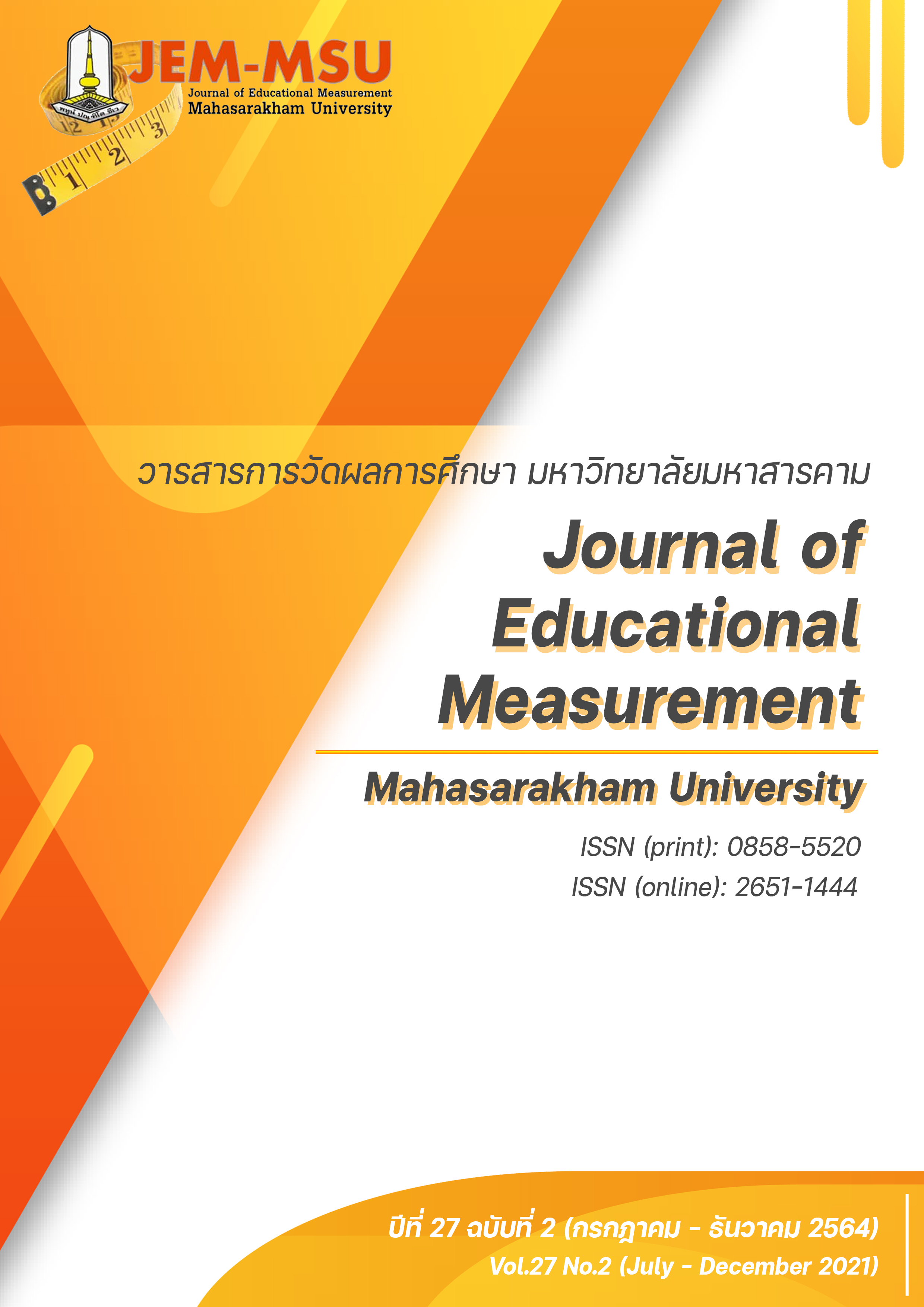A Study of the Behavior in Using Facebook of Bachelor’s Degree Students in the Faculty of Education, Mahasarakham University
Main Article Content
Abstract
This research aimed to 1) study the behavior in using Facebook of bachelor’s degree students in the Faculty of Education, Mahasarakham University, 2) study the benefits of using Facebook for the bachelor’s degree students in the Faculty of Education, Mahasarakham University, and 3) study the impacts of using Facebook on the bachelor’s degree students in the Faculty of Education, Mahasarakham University. The sample consisted of 150 bachelor’s degree students in the Faculty of Education, Mahasarakham University, enrolled in the academic year 2018, selected through stratified random sampling, using the majors as strata. The instrument was a questionnaire on the behavior in using Facebook. The statistics used were the mean, standard deviation and percentage.
The result showed that 1) 44 percent of the students, the largest group, used Facebook at the university; 77.30 percent used Facebook every day; 28.00 percent used Facebook for 3-4 hours per day; most students or 86.00 percent used it in their spare time, from 6.00 to 11.59 pm. The students’ behavior in using Facebook had the overall propriety in the moderate level; 2) the benefits of using Facebook for the bachelor’s degree students, on the whole, were in the high level; the benefits of using Facebook were on educational purposes such as submitting assignments, making inquiries and learning. 3) The impacts of using Facebook on the students, on the whole, were in the low level, the minimal impacts were physical accidents such as bumping into someone, or falling, caused by using Facebook while walking.
Article Details
The content and information contained in the published article in the Journal of Educational Measurement Mahasarakham University represent the opinions and responsibilities of the authors directly. The editorial board of the journal is not necessarily in agreement with or responsible for any of the content.
The articles, data, content, images, etc. that have been published in the Journal of Educational Measurement Mahasarakham University are copyrighted by the journal. If any individual or organization wishes to reproduce or perform any actions involving the entirety or any part of the content, they must obtain written permission from the Journal of Educational Measurement Mahasarakham University.
References
กันตธีร์ อนันตพงศ์ และจารุรินทร์ ปิตานุพงศ์. (2557). ผลของ Facebook ต่อนักศึกษามหาวิทยาลัย สงขลานครินทร์วิทยาเขตหาดใหญ่. สงขลานครินทร์เวชสาร, 32 (6), 393 - 404.
ตฤณธวัช วงษ์ประเสริฐ และ กุลทิพย์ ศาสตระรุจิ. (2559). ทัศนคติและพฤติกรรมการงานเฟซบุค (Facebook) ของวัยทำงานใน กรุงเทพมหานคร. วารสารนิเทศศาสตร์และนวัตกรรม นิด้า, 3 (2), 29 - 46.
จุฑารัตน์ ศราวณะวงศ์ และ คณะ. (2560). พฤติกรรมการใช้สื่อสังคมออนไลน์ ของนิสิตระดับปริญญาตรี มหาวิทยาลัยเกษตรศาสตร์. วารสารบรรณศาสตร์ มศว, 10(2), 16 -31.
จิรภัทร เริ่มศรี. (2558). พฤติกรรมการใช้เฟซบุ๊กที่มีผลกระทบต่อนักศึกษา มหาวิทยาลัยราชภัฏสกลนคร. JOURNAL OF NAKHONRATCHASIMA COLLEGE, 9(1), 59 – 65.
ทิพรัตน์ สิทธิวงศ์. (2558). การศึกษาความคิดเห็นของนิสิตที่มีต่อการใช้ Facebook ในการเรียนการสอน รายวิชาการออกแบบและผลิตสื่อกราฟิกเพื่อการศึกษา สำหรับนิสิตระดับปริญญาตรี สาขาเทคโนโลยีและสื่อสารการศึกษา คณะศึกษาศาสตร์ มหาวิทยาลัยนเรศวร. วารสารศึกษาศาสตร์ มหาวิทยาลัยนเรศวร, 17(3), 82 -88.
บุญชม ศรีสะอาด. (2556). การวิจัยเบื้องต้น. พิมพ์ครั้งที่ 9. กรุงเทพฯ: สุรีวิทยาสาสน์.
บุญอยู่ ขอพรประเสริฐ. (2557). พฤติกรรมการใช้เฟซบุ๊ก (Facebook) ของนักศึกษาในเขตกรุงเทพมหานคร. วารสารร่มพฤกษ์ มหาวิทยาลัยเกริก, 32(2), 1–23.
พิจารณ์ เจริญศรี และ คณะ. (2560). อิทธิพลของการใช้เฟซบุ๊กที่มีต่อผลการเรียนของนักศึกษาในเขตกรุงเทพมหานคร. BUACADEMIC REVIEW, 16(1), 120-139.
ภาณุวัฒน์ กองราช. (2554). การศึกษาพฤติกรรมการใช้เครือข่ายสังคมออนไลน์ของวัยรุ่นในประเทศไทย: กรณีศึกษา Facebook. วิทยานิพนธ์ วิทยาศาสตรมหาบัณฑิต สาขาการบริหารเทคโนโลยี มหาวิทยาลัยธรรมศาสตร์.
ภัทรศิชา นวลศรี และ มาลี สบายยิ่ง. (2559). พฤติกรรมการใช้เฟซบุ๊ก (Facebook) กับความฉลาดทางอารมณ์ ของนักศึกษามหาวิทยาลัยราชภัฏสงขลา.วารสารบัณฑิตศึกษา มนุษยศาสตร์และสังคมศาสตร์ มหาวิทยาลัยข่อนแก่น, 5(2), 157–178.
วรรณชร ไชยเดช และ ก้องกาญจน์ วชิรพนัง. (2557). การใช้โซเชียลมีเดียกับการจัดการเรียนการสอน : เฟสบุคกับการสร้างแรงจูงใจการเรียนของนักศึกษา. Proceedings การประชุมวิชาการระดับชาติ เปิดโลกกว้างทางปัญญา วิชาศึกษาทั่วไป – GEN Conference 2014 Open World, 213 – 225.
วรัชญา โคตรพัฒน์. (2558). พฤติกรรมการใช้ Facebook Fanpage Bangkok Bank Credit Card ของผู้ถือบัตรเครดิต ที่มีผลต่อการตัดสินใจใช้ผลิตภัณฑ์และบริการ. การค้นคว้าอิสระ นิเทศศาสตรมหาบัณฑิต มหาวิทยาลัยกรุงเทพ.
แอนณา อิ่มจำลอง และ วิไลวรรณ จงวิไลเกษม. (2556). การใช้เฟซบุ๊คเป็นช่องทางการสื่อสารการเรียนการสอนทางด้าน นิเทศศาสตร์. วารสารนิเทศศาสตร์ธุรกิจบัณฑิตย์, 7(2),75–93.


